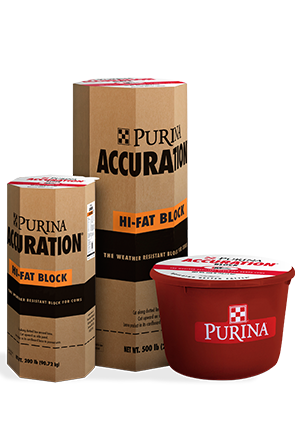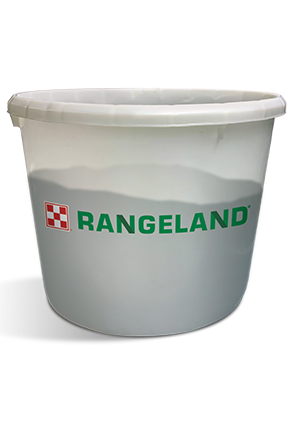
3 Benefits of Block and Tub Supplements
Management : Cow & Calf
Management : Replacement
Supporting cattle’s nutrient needs as forage quality declines is a must. But how can you accomplish this in an efficient, easy-to-manage way?
Block and tub supplements are a great option to keep cattle performing at their peak without the stress of additional labor or management needs. Here are three reasons to choose blocks or tubs for your supplementation needs:
New ClearView packaging for Purina® RangeLand® Protein tubs expand the labor savings and convenience even more. With colored tubs, you need to get close to the tubs to see how much product is remaining. With the new clear tubs, you can see the product from a distance. You can easily see how much product is left and better monitor intake while saving time and labor checking tubs.
Putting out supplement tubs as soon as forage quality starts to decline, or before, ensures cattle don’t miss a beat. And, with blocks containing Intake Modifying Technology®, cattle can consume small amounts of supplement and gradually increase intake as forage quality declines.
Protein or high-fat tubs and blocks are designed as a supplement to forage, not a substitution. Intake levels can give you an indication of whether or not you need to adjust your available forage. If supplement intake reaches the upper end of the targeted intake levels on the tag, it’s an indication there’s probably not enough forage available, and you may want to provide additional hay or other forages.
Cooked tubs, like Purina® RangeLand® Protein tubs, are molasses-based and provide very consistent intake at 0.5-1 pound per head per day. They are formed by cooking molasses under a vacuum until very low in moisture. Dry ingredients are then mixed with the cooked molasses, poured into tubs and cooled over 24 hours. The end product is very hard and has a crystalline texture. This hardness is what controls the level of consumption. Cooked tubs absorb moisture from the environment or animals licking on them. The moisture dissolves a thin layer of product for cattle to eat.
Block products, such as Purina® Accuration® Hi-Fat block, are formed by blending molasses with the dry ingredients. The resultant mix is poured into the container, and as the mix cools, it hardens. Poured blocks are softer than cooked tubs and have more variable intakes, around 1-3 pounds per head per day, based on nutritional needs of the animals and forage quality. Purina® Accuration® Hi-Fat blocks with Intake Modifying Technology® allows intake of the block to go up or down as forage quality improves or declines.
Both cooked tubs and poured blocks are options to deliver supplemental nutrients to cows grazing fair to poor quality forage to aid in maintaining body condition. There are also additional options to meet your exact needs, including high-fat and higher-percentage protein products.
Does your nutrition program stack up? Find out with a Proof Pays trial.
Block and tub supplements are a great option to keep cattle performing at their peak without the stress of additional labor or management needs. Here are three reasons to choose blocks or tubs for your supplementation needs:
1. Labor savings
Tubs and blocks offer easier management to save you time and labor compared to other product forms. With tubs and blocks being convenient self-fed forms, they provide nutrition 24/7, allowing all cows a chance to consume the product when they need it. Since you don’t need to deliver supplement every day, you save on feed delivery time and costs.New ClearView packaging for Purina® RangeLand® Protein tubs expand the labor savings and convenience even more. With colored tubs, you need to get close to the tubs to see how much product is remaining. With the new clear tubs, you can see the product from a distance. You can easily see how much product is left and better monitor intake while saving time and labor checking tubs.
2. Supports intake
Tubs and blocks offer a convenient way for cattle to get the nutrition they need when forages decline in quality and are deficient in protein, energy, vitamins and minerals. They allow cows to eat what they need when they need it.Putting out supplement tubs as soon as forage quality starts to decline, or before, ensures cattle don’t miss a beat. And, with blocks containing Intake Modifying Technology®, cattle can consume small amounts of supplement and gradually increase intake as forage quality declines.
Protein or high-fat tubs and blocks are designed as a supplement to forage, not a substitution. Intake levels can give you an indication of whether or not you need to adjust your available forage. If supplement intake reaches the upper end of the targeted intake levels on the tag, it’s an indication there’s probably not enough forage available, and you may want to provide additional hay or other forages.
3. Flexible product options
Both blocks and cooked tubs accomplish the same thing – stimulating forage intake, delivering protein, energy, vitamins and minerals, and aiding digestion. The difference is in how they are manufactured and used. Regardless of form, you have options based on your specific needs.Cooked tubs, like Purina® RangeLand® Protein tubs, are molasses-based and provide very consistent intake at 0.5-1 pound per head per day. They are formed by cooking molasses under a vacuum until very low in moisture. Dry ingredients are then mixed with the cooked molasses, poured into tubs and cooled over 24 hours. The end product is very hard and has a crystalline texture. This hardness is what controls the level of consumption. Cooked tubs absorb moisture from the environment or animals licking on them. The moisture dissolves a thin layer of product for cattle to eat.
Block products, such as Purina® Accuration® Hi-Fat block, are formed by blending molasses with the dry ingredients. The resultant mix is poured into the container, and as the mix cools, it hardens. Poured blocks are softer than cooked tubs and have more variable intakes, around 1-3 pounds per head per day, based on nutritional needs of the animals and forage quality. Purina® Accuration® Hi-Fat blocks with Intake Modifying Technology® allows intake of the block to go up or down as forage quality improves or declines.
Both cooked tubs and poured blocks are options to deliver supplemental nutrients to cows grazing fair to poor quality forage to aid in maintaining body condition. There are also additional options to meet your exact needs, including high-fat and higher-percentage protein products.
Does your nutrition program stack up? Find out with a Proof Pays trial.




